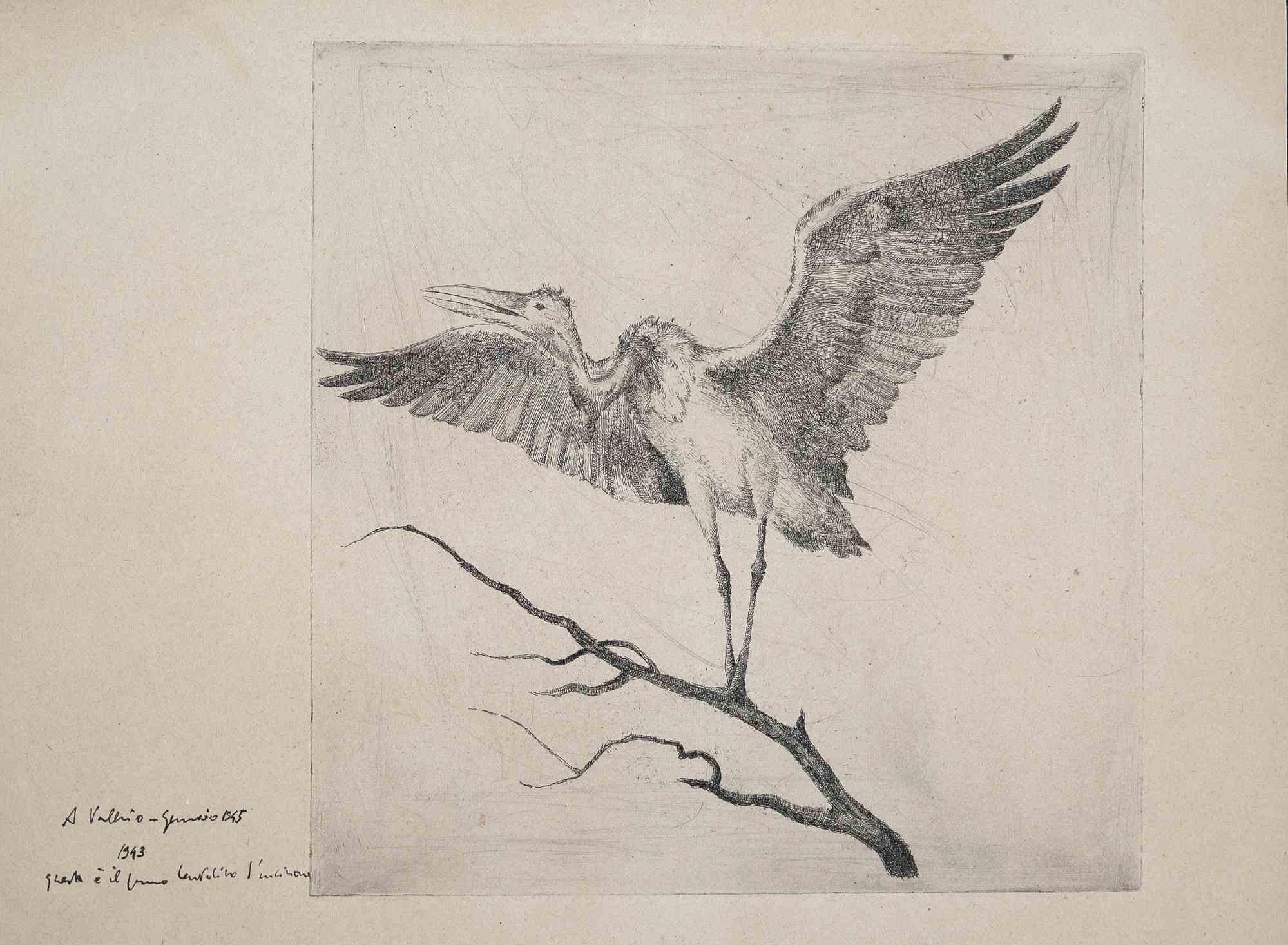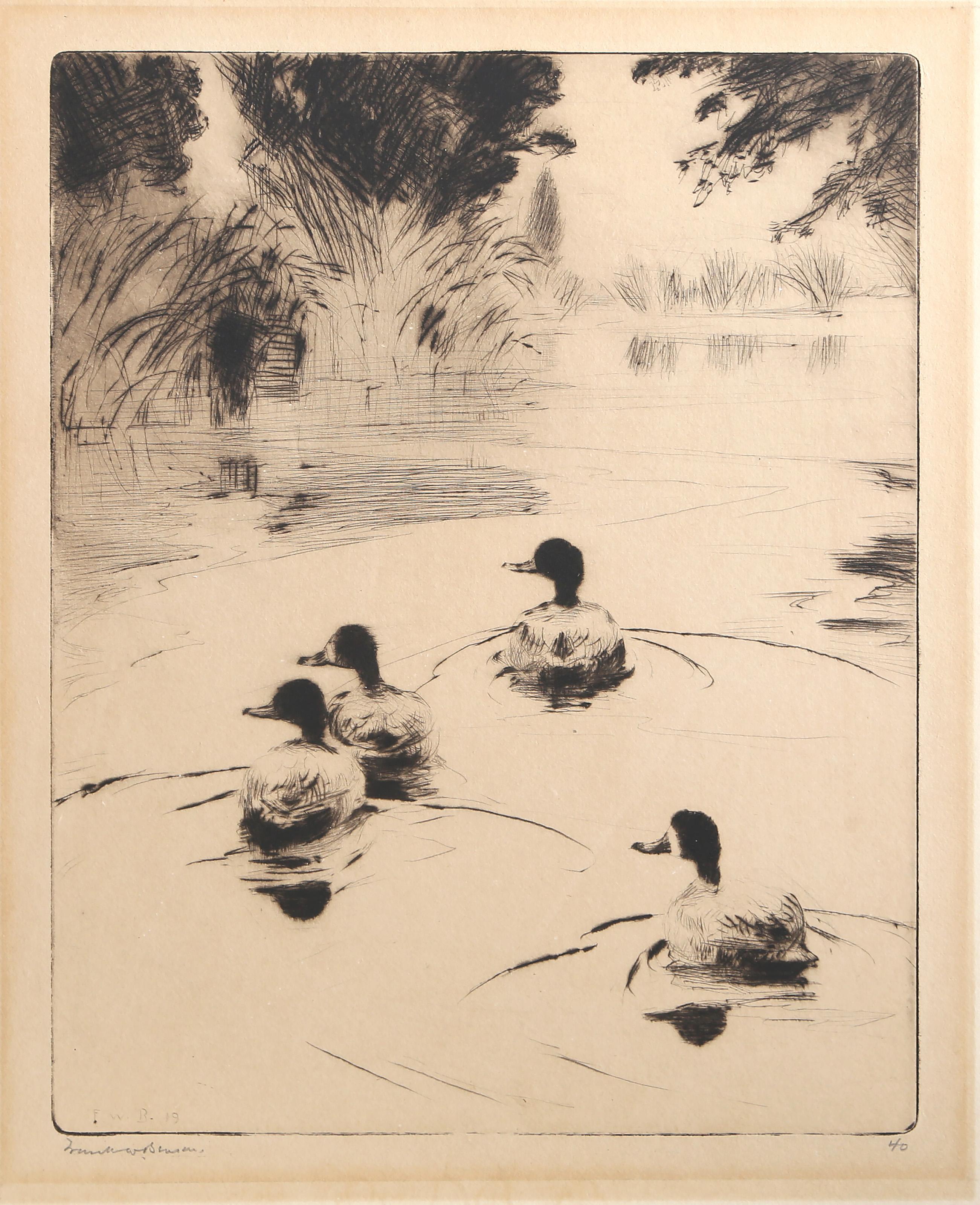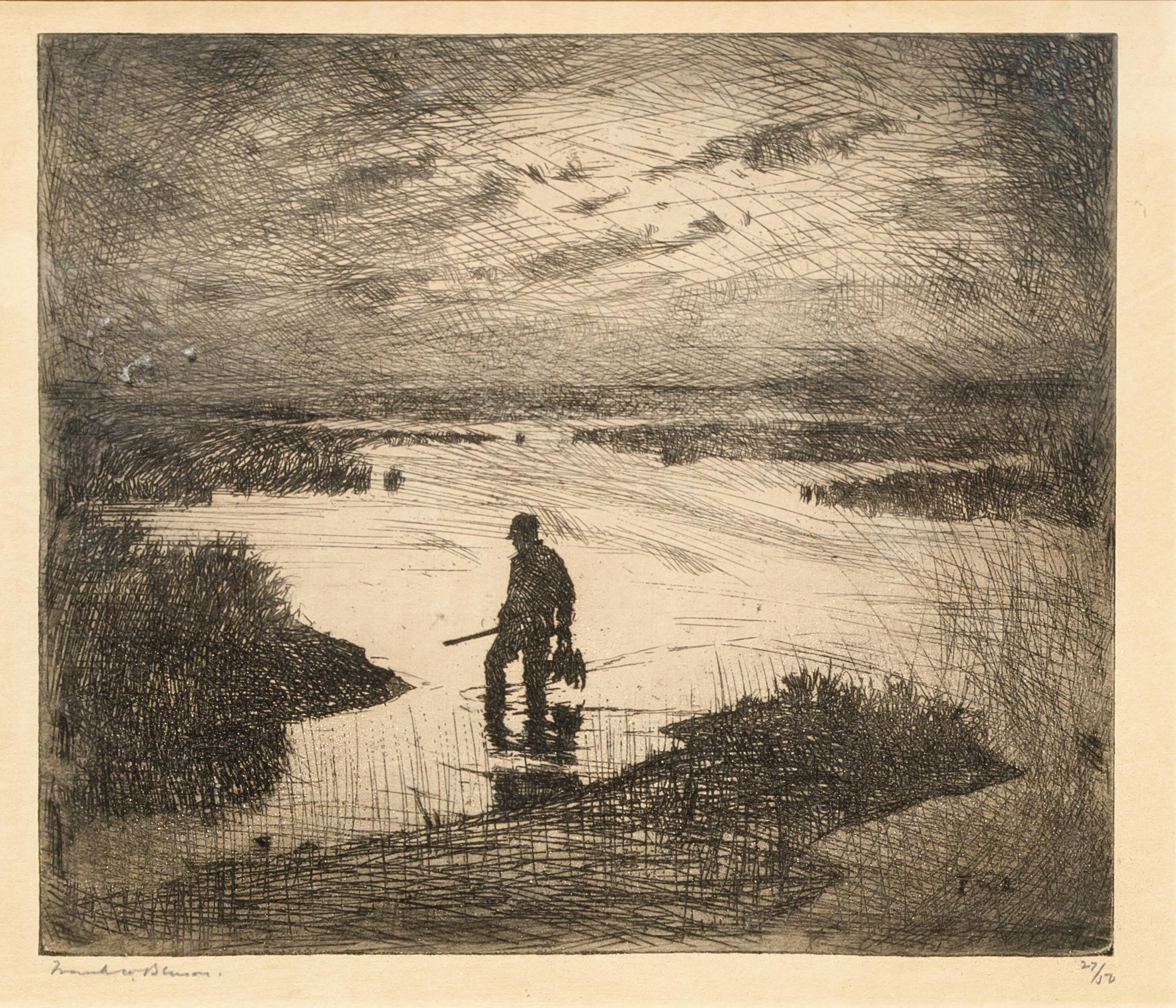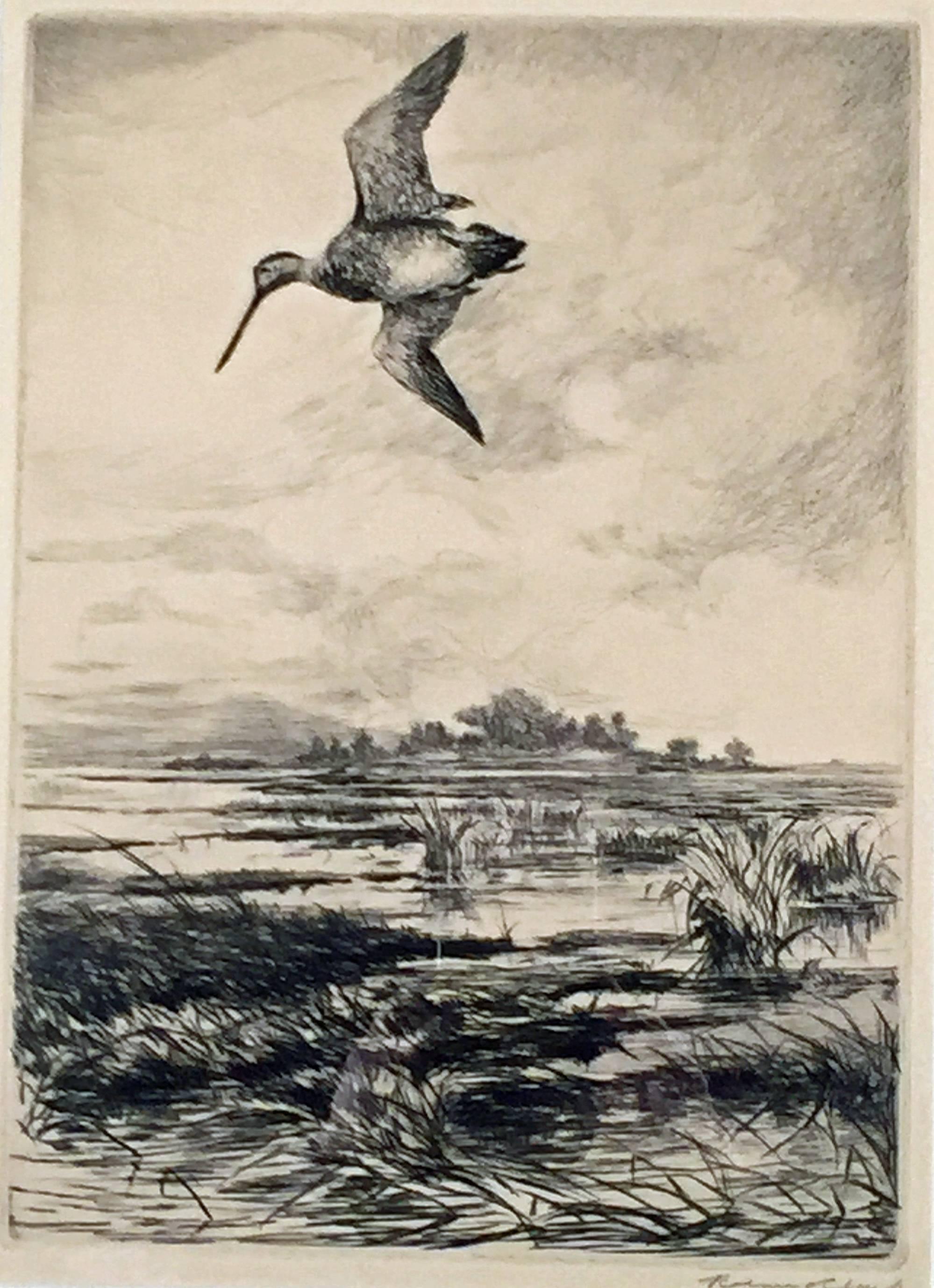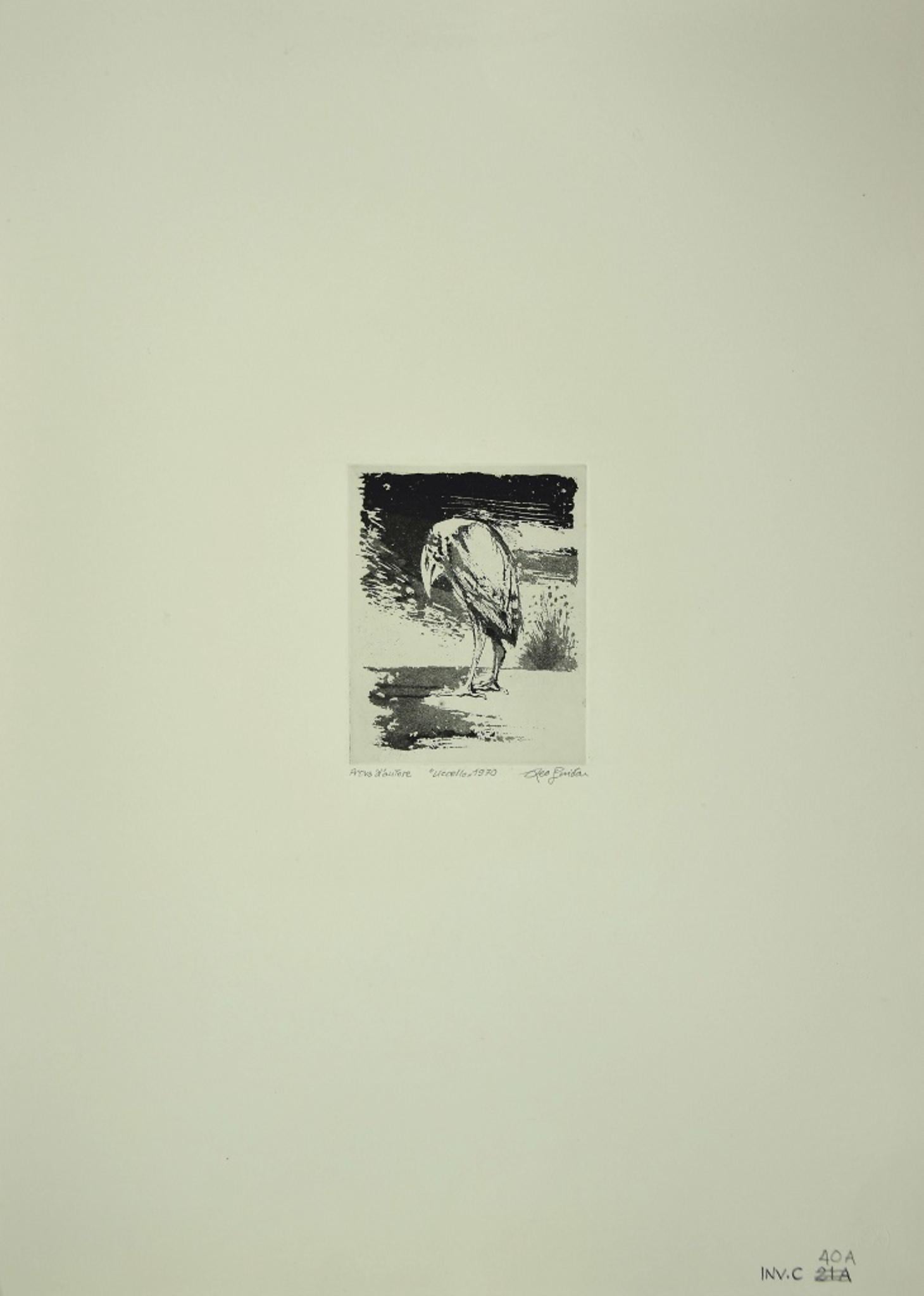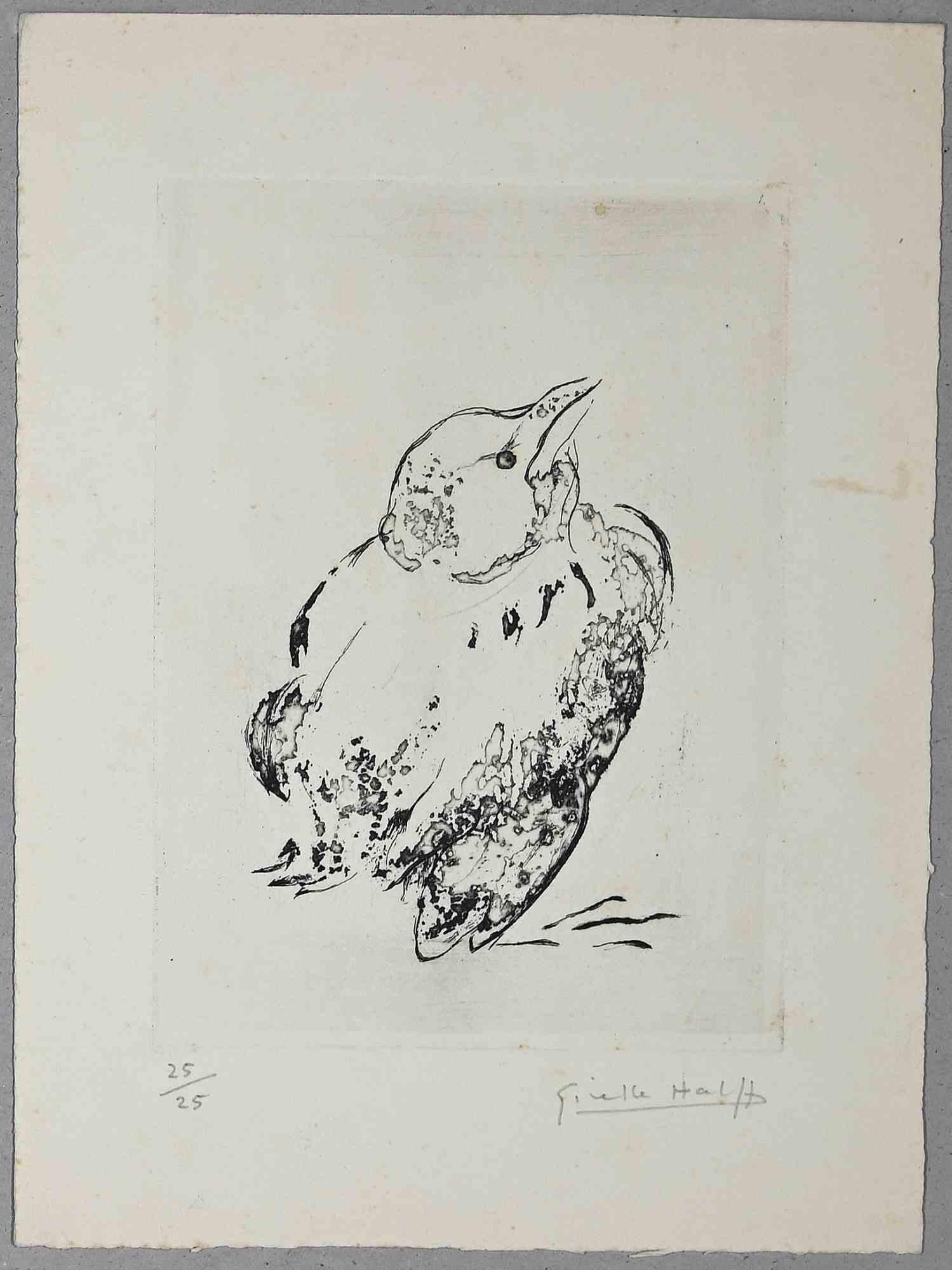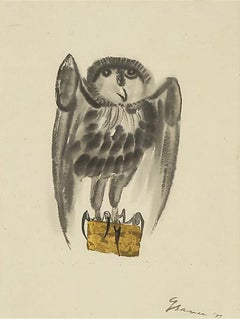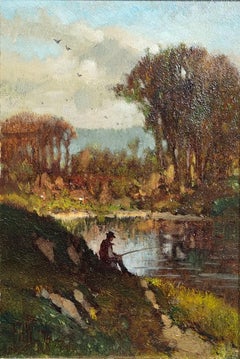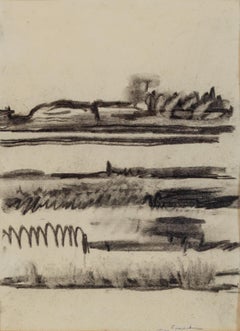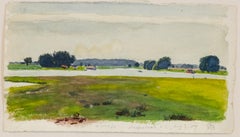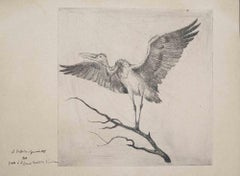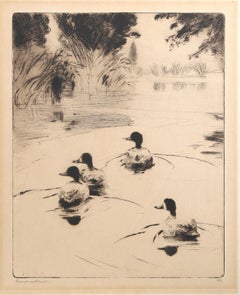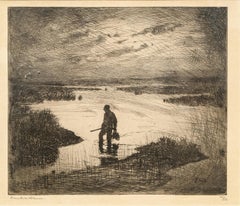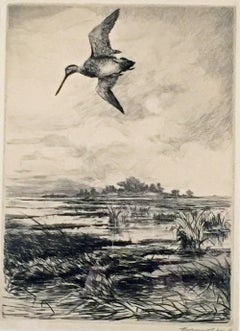Items Similar to "Woodcock" Frank Weston Benson, 1930s Etching of Bird, Sandpiper, Nature
Want more images or videos?
Request additional images or videos from the seller
1 of 8
Frank Weston Benson"Woodcock" Frank Weston Benson, 1930s Etching of Bird, Sandpiper, Nature 1930
1930
$3,500
£2,673.66
€3,072.02
CA$5,004.25
A$5,513.52
CHF 2,854.13
MX$66,384.15
NOK 36,140.18
SEK 33,951.41
DKK 22,936.54
About the Item
Frank Weston Benson
Woodcock, 1930
Signed lower right
Etching on paper
Image 8 3/4 x 7 inches
Edition of 150
Born in Salem, Massachusetts, a descendant of a long line of sea captains, Benson first studied art at Boston’s Museum School where he became editor of the student magazine. In 1883, Benson enrolled at the Académie Julian in Paris where artists such as Bouguereau, Lefebvre, Constant, Doucet and Boulanger taught students from all over Europe and America. It was Boulanger who gave Benson his highest commendation. “Young man,” he said, “Your career is in your hands . . . you will do very well.” Benson’s parents gave him a present of one thousand dollars a twenty-first birthday and told him to return home when it ran out. The money lasted long enough to provide Benson with two years of schooling in Paris, a summer at the seaside village of Concarneau in Brittany and travel in England.
Upon returning to America, Benson opened a studio on Salem’s Chestnut Street and began painting portraits of family and friends. An oil of his wife, Ellen Perry Peirson, dressed in her wedding gown is representative of this period. It demonstrates not only the academic techniques he learned at the Academie Julian but also his own growing emphasis on the effects of light. And yet, despite all the technical mastery displayed in the work, the painting exudes the warmth that existed between model and artist. More than a likeness, it is a study in serenity. Perhaps it was of a work such as this that Benson was thinking when he said, “The more a painter knows about his subject, the more he studies and understands it, the more the true nature of it is perceived by whoever looks at it, even though it is extremely subtle and not easy to see or understand. A painter must search deeply into the aspects of a subject, must know and understand it thoroughly before he can represent it well.”
Following a brief stint as an instructor at the Portland, Maine, Society of Art, Benson was appointed as instructor of antique drawing at the Museum School in Boston in the spring of l889. Benson’s long association with the school was particularly fruitful. Under the leadership of Edmund Tarbell and Benson the Museum School became a national and internationally recognized institution. The students won numerous prizes, enrollment tripled, a new school building was erected and visiting delegations from other schools sought the secret of their success. Benson cherished his role as teacher and was held in high esteem by his students, many of whom called him “Cher Maitre.” Reminiscing about his long career with the school Benson once said, “I may have taught many students, but it was I who learned the most.”
In 1890, Benson won the Hallgarten Prize at the National Academy in New York. It was the first of a long series of awards, that earning for him the sobriquet “America’s Most Medalled Painter.” In the early years of his career, Benson’s studio works were mostly portraits or paintings of figures set in richly appointed interiors. Young women in white stretch their hands out towards the glow of an unseen fire; girls converse on an antique settee in a room full of objets d’arts; his first daughter, Eleanor, poses with her cat. Works of this sort, together with a steady influx of portrait commissions, earned Benson both renown and financial rewards, yet it was in his outdoor works that gave Benson his greatest pleasure.
In the latter half of the 1890s, Benson summered in Newcastle, on New Hampshire’s short stretch of seacoast. It was here, in 1899, that Benson made his first foray into impressionism with Children in the Woods and The Sisters, the latter a sun-dappled study of his two youngest daughters, Sylvia and Elisabeth.
This painting was one of the first works that Benson hung at an exhibition with nine friends. The resignation of these ten illustrious artists rocked the American art establishment but, the catalogue for their first exhibition was titled, simply, “Ten American Painters.” When, in 1898, the three Bostonians and seven New Yorkers began to exhibit their best work in exquisitely arranged small shows, the group (dubbed by newspapers, “The Ten” ) quickly became known as the American Impressionists, a bow to the style of their French predecessors. The Ten’s annual shows soon became an eagerly awaited part of the annual exhibition calendar and were always well reviewed. Held annually in New York City, the group’s yearly exhibitions usually traveled to Boston and were occasionally seen in other cities. Benson’s association with other members of the group such as Childe Hassam, Thomas Dewing, William Merrit Chase and J. Alden Weir, only reinforced his growing emphasis on the tenets of Impressionism. As he later said to his daughter Eleanor, “I follow the light, where it comes from, where it goes.”
The principles of Impressionism began to dominate Benson’s work by 1901, the year that the Bensons first summered on the island of North Haven in Maine’s Penobscot Bay. His summer home “Wooster Farm,” which they rented and finally bought in 1906, became the setting for some of Benson’s best known work and there, it seemed, he found endless inspiration. Benson’s sparkling plein-air paintings of his children–Eleanor, George, Elisabeth and Sylvia–capture the very essence of summer and have been widely reproduced: In The Hilltop, George and Eleanor watch the sailboat races from the headland near their house.
As a boy, Benson dreamed of being an ornithological illustrator. In mid-life, he returned to the wildfowl and sporting subjects that had remained his lifelong passion. Using etching and lithography, watercolor, oil and wash, Benson portrayed the birds observed since childhood and captured scenes of his hunting and fishing expeditions.
Together with his two brothers-in-law, Benson bought a small hunting retreat on a hill overlooking Cape Cod’s Nauset Marsh. Here, in the late 1890s, he began experimenting with black and white wash drawings. These paintings became so popular that Benson was not able to keep up with the demand. He turned to an art publishing company to have several made into it intaglio prints; twelve wash drawings are known to have been reproduced in this manner. At least two of them were given as gifts to associate members of the Boston Guild of artists, of which Benson was a founding member.
Benson was also an avid fisherman and his salmon fishing expeditions to Canada’s Gaspé Peninsula where one of the high points of his summer. There, in 1921, he began the first in a series of watercolors that would eventually over 500 works.
Benson’s watercolors conveyed the joy and beauty of a sportsman’s life whether in a painting of a hunter setting out decoys, a flock of ducks coming in for a landing or a grouse flushed from cover. The critics favorably compared Benson’s watercolors to those of Homer. “The love of the almost primitive wilderness which appears in many of Homer’s landscapes and the swift, sure touch with which he suggests rather than describes–these also characterize Benson’s work,” one critic wrote. “The solitude of the northern woods is very much like Homer’s.”
Like the wash drawings before them, Benson’s watercolors proved so popular that he had great difficulty keeping up with the public demand. He often had to write to dealers declining their requests for paintings. “I had several [paintings for you],” he wrote to a gallery owner in New York City, “but people saw them and bought them about as soon as they were dry–I sold eight last week and you get what you have because I hid them.”
Benson also painted a number of sporting scenes in oil. In such dramatic works as Hunter in a Boat one can sense the cold, biting damp of a New England winter day chilling the hunter as he pulls his boat through the choppy sea. This work, which depicts Black Rock Ledge not far from Benson’s home in Salem, was one of his earliest sporting oils.
If some of Benson’s sporting works may be more about the landscape than the sportsman, it is also true that a number of his studio works appear to be more still life than figure study. In such paintings as The Black Hat, the chest of drawers, the objects on the table, even the hat itself, are as important to the composition as the model posing in the foreground. “A picture is merely an experiment in design,” Benson once told his daughter, Eleanor. “If the design is pleasing, the picture is good, no matter whether composed of objects, still life, figures or birds. Few appreciate that what makes them admire a picture is the design made by the painter.”
Beginning around 1919, Benson began a series of true still lifes. Many of these handsome tabletop arrangements, composed of objects gathered by Benson’s seafaring ancestors on their trips to the Orient, have found homes in America’s major museums. These porcelains, candlesticks, Oriental screens, and embroidered silk tablecloths, have been arranged and rearranged by the artist to create a number of a handsome compositions.
In addition to oils, Benson also used watercolor as a medium for executing still lifes. Most often these paintings, such as Nasturtiums in a Vase, or Phlox in a Pewter Pitcher were arrangements made from flowers gathered from Ellen Benson’s gardens at North Haven.
While many collectors know Benson as a painter, a totally different group of admirers are aware of him only as an etcher of sporting scenes. It is almost as though there were two Bensons.
In 1911, simply as a form of recreation, Benson began experimenting with the art of etchings in his barn studio in Maine. In letters to an artist friend, Charles Woodbury, Benson revealed a growing fascination with this medium during the first few years of his printmaking. During the next four years, he completed several dozen etchings although he did not exhibit any of them. In 1915, at the urging of friends, he included a few of his etched pieces at a one-man show at the Guild of Boston Artists. The etchings sold out within a week and the demand for Benson’s etchings grew steadily over the ensuing decades. Collectors placed standing orders for each new edition and, at one point, Benson had to write a dealer in dismay that “We are not exactly happy over the etching question ourselves. A sudden increase in the demand last year used up our stock in a month. This year they have been mostly sold in a week, apparently. Out of an edition of l50, we keep 25 to sell at advance prices when the first l25 are sold. "
With the etcher’s needle, Benson was able to command the same mastery of light that he demonstrated years before in his sun-drenched paintings of his children on an summer hillside. Whether in a subtle portrait of his wife doing her hair by candlelight, a guide dipping a cup of water from a mountain stream, or a group of boats reflected in the water, Benson’s mastery of etching was greeted with overwhelming praise by critics. Exhibitions of his etched work were held in every major city in America as well as in London. Benson has often been credited with being the founder of the school of the American sporting print and his etchings sell as briskly now as they did eighty years ago.
Benson began winning awards in l890 with his dramatic interior studies, won national and international recognition for his luminous plein air paintings in the early 1900s and was still garnering prizes in the 1920s and 1930s for his watercolors of sporting scenes and his stunning oils of birds. Benson’s last prize was awarded to him for his etchings at the age of 86.
- Creator:Frank Weston Benson (1862-1951, American)
- Creation Year:1930
- Dimensions:Height: 15 in (38.1 cm)Width: 12.75 in (32.39 cm)
- More Editions & Sizes:Unique workPrice: $3,500
- Medium:
- Movement & Style:
- Period:
- Condition:
- Gallery Location:New York, NY
- Reference Number:1stDibs: LU1841217051192
About the Seller
5.0
Platinum Seller
Premium sellers with a 4.7+ rating and 24-hour response times
Established in 2022
1stDibs seller since 2022
123 sales on 1stDibs
Typical response time: <1 hour
- ShippingRetrieving quote...Shipping from: New York, NY
- Return Policy
Authenticity Guarantee
In the unlikely event there’s an issue with an item’s authenticity, contact us within 1 year for a full refund. DetailsMoney-Back Guarantee
If your item is not as described, is damaged in transit, or does not arrive, contact us within 7 days for a full refund. Details24-Hour Cancellation
You have a 24-hour grace period in which to reconsider your purchase, with no questions asked.Vetted Professional Sellers
Our world-class sellers must adhere to strict standards for service and quality, maintaining the integrity of our listings.Price-Match Guarantee
If you find that a seller listed the same item for a lower price elsewhere, we’ll match it.Trusted Global Delivery
Our best-in-class carrier network provides specialized shipping options worldwide, including custom delivery.More From This Seller
View All"Offering, " Morris Graves, American Modernism, Owl, Bird, Gift, Present
By Morris Graves
Located in New York, NY
Morris Graves
Offering, 1957
Signed and dated lower right
Sumi ink wash and gold leaf on paper
18 x 13 3/8 inches
Born in Fox Valley, Oregon in 1910, Morris Graves was a leading proponent of the Northwest School...
Category
1950s Modern Animal Drawings and Watercolors
Materials
Gold Leaf
"Fishing in Autumn" Frederick Dickinson Williams, Early 20th Century Landscape
Located in New York, NY
Frederick Dickinson Williams
Fishing in Autumn, 1914
Signed and dated lower left
Oil on board
9 1/4 x 6 7/8 inches
Frederick Dickinson W...
Category
1910s Academic Figurative Paintings
Materials
Board, Oil
"Untitled I" Jane Freilicher, Hamptons Landscape Drawing, Mid-century Abstract
By Jane Freilicher
Located in New York, NY
Jane Freilicher
Untitled I, 1958-59
Signed lower right
Charcoal on paper
11 1/2 x 8 3/4 inches
Provenance:
Tibor de Nagy Gallery, New York
Private Collection, New York
Jane Freilic...
Category
1950s Modern Landscape Drawings and Watercolors
Materials
Paper, Charcoal
"Sheepshead, Brooklyn, Long Island" Oscar Bluemner, Modernist Watercolor
By Oscar Bluemner
Located in New York, NY
Oscar Bluemner
Sheepshead, Long Island, 1907
Signed with the artist's conjoined initials "OB" and dated "4-30 - 5 - 30" / "Aug 3, 07"
Watercolor on paper
6 x 10 inches
Provenance:
J...
Category
Early 1900s American Modern Landscape Drawings and Watercolors
Materials
Paper, Watercolor
"The Riverbank" Charles Sprague Pearce, American Impressionist Boat Sketch
By Charles Sprague Pearce
Located in New York, NY
Charles Sprague Pearce
The Riverbank, circa 1900
Signed lower left, inscribed verso
Oil on canvas
7 1/2 x 5 1/2 inches
Charles Sprague Pearce made a successful career painting high...
Category
Early 1900s American Impressionist Figurative Paintings
Materials
Canvas, Oil
"Beach Scene at Dieppe" James Abbott McNeill Whistler, Tonalist Watercolor
By James Abbott McNeill Whistler
Located in New York, NY
James Abbott McNeill Whistler
Beach Scene at Dieppe, 1885-86
Watercolor on paper, mounted on board
8 1/2 x 5 inches
Signed on the reverse
Provenance:
Miss Annie Burr Jennings
Mrs. ...
Category
1880s Impressionist Landscape Drawings and Watercolors
Materials
Paper, Watercolor
You May Also Like
The Bird - Original Etching - 1945
Located in Roma, IT
The Bird is an original Etching, realized by an anonymous artist in 1945.
The status of preservation Good.
The artwork is depicted skillfully through confident and strong lines wit...
Category
1940s Modern Figurative Prints
Materials
Etching
Ducks at Play, Signed Modern Etching Mounted to Board by Frank Weston Benson
By Frank Weston Benson
Located in Long Island City, NY
Ducks at Play
Frank Weston Benson, American (1862–1951)
Date: 1940
Etching mounted to board, signed and dated in pencil
Image Size: 10 x 8 inches
Size: 12 x 10 in. (30.48 x 25.4 cm)
Category
1940s Modern Animal Prints
Materials
Etching
Frank Weston Benson Original Etching, Early 20th Century
By Frank Weston Benson
Located in New York, NY
Frank Weston Benson (American, 1862-1951)
Untitled, 20th Century
Etching
Sight: 10 1/3 x 12 1/8 in.
Framed: 16 3/4 x 19 x 1/2 in.
Signed lower left
Numb...
Category
20th Century Modern Figurative Prints
Materials
Etching
JACK SNIPE
By Roland Clark
Located in Portland, ME
Clark, Roland (American 1874-1957). JACK SNIPE. Etching, 1928. Edition of 70. Signed in pencil. 8 1/2 x 12 inches. In excellent condition.
Category
1920s American Realist Animal Prints
Materials
Etching
$680 Sale Price
20% Off
Bird - Original Etching by Leo Guida - 1970
By Leo Guida
Located in Roma, IT
Bird is an original Contemporary artwork realized in 1970 by the italian artist Leo Guida.
Original Etching on paper.
Titled, hand-signed and dated in pencil on the lower margin: ...
Category
1970s Contemporary Animal Prints
Materials
Etching, Paper
Bird - Original Etching and Aquatint by Giselle Hallf - Mid-20th Century
By Giselle Halff
Located in Roma, IT
Bird is an original etching and aquatint by Giselle Hallf in the half of the 20th Century.
Good conditions.
Numbered, Edition 25/25.
The artwork is depicted through strong strokes...
Category
Mid-20th Century Contemporary Figurative Prints
Materials
Etching, Aquatint
